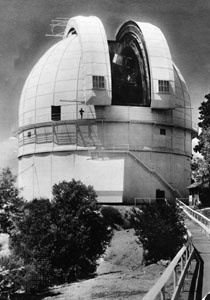Mount Wilson Observatory
observatory, California, United States
 astronomical observatory located atop Mount Wilson, about 10 miles (16 km) northeast of Pasadena, Calif., U.S.
astronomical observatory located atop Mount Wilson, about 10 miles (16 km) northeast of Pasadena, Calif., U.S.It was established in 1904 by American astronomer George Ellery Hale (Hale, George Ellery) as a solar-observing station for the Yerkes Observatory, but it soon became an independent observatory funded by the Carnegie Institution of Washington. Hale built a series of ever-larger solar telescopes (telescope) at the summit of Mount Wilson. In 1908 a 60-inch (152-cm) reflector, then the largest in the world, was added for observations of stars (star) and galaxies (galaxy). In the same year, Hale used both his solar telescopes and his laboratory experiments to demonstrate that sunspots (sunspot) were magnetically active regions in the Sun's photosphere. A complementary physics laboratory and suite of administrative and maintenance offices were also built in nearby Pasadena, making Mount Wilson the first stratified observatory complex in the world.
In 1918 a 100-inch (254-cm) reflecting telescope was put into service. It was not only the most powerful telescope in the world but also a versatile astronomical test bed for new observational techniques. In 1920 the angular diameter of a star was first measured with an interferometer mounted on this telescope, and soon the telescope was being used for astronomical spectroscopy that exploited not only the enormous light-gathering power of the 100-inch mirror but also the innovative subterranean Coudé focus that accommodated a wide range of spectroscopic devices.
The 100-inch telescope's most important discovery was American astronomer Edwin Hubble (Hubble, Edwin Powell)'s determination of the distance to the Andromeda Nebula (Andromeda Galaxy) in 1924. He showed that the nebula lay beyond the bounds of the Milky Way Galaxy and hence was a galaxy in its own right. Then in 1929, building on the work of American astronomer Vesto Slipher (Slipher, Vesto Melvin), Hubble and his assistant Milton Humason demonstrated that galaxies were moving away from one another. This movement is the expansion of the universe. Throughout the 1930s and '40s, Hubble and his associates used the 100-inch reflector to refine the extragalactic distance scale and to probe the large-scale structure of the universe.
In 1944 the German-born American astronomer Walter Baade successfully resolved the inner regions of the Andromeda Galaxy with the 100-inch reflector and performed photometric studies that showed two populations of stars of different ages and compositions. The difference between the two populations, called Populations I and II, was a critical clue to the evolution of galaxies.
The 100-inch telescope remained the largest telescope in the world until 1948, when it was surpassed by the Palomar Observatory's 200-inch (504-cm) Hale Telescope, which was designed largely by Mount Wilson staff. Palomar was initially operated jointly by Mount Wilson and the California Institute of Technology, and eventually the two observatories were combined as the Hale Observatories. They are now separate entities, and, although Mount Wilson is still owned by the Carnegie Institution of Washington, it is operated by a consortium known as the Mount Wilson Institute (MWI). MWI has updated the instrumentation, including the 60- and 100-inch reflectors and the solar telescopes. These updates took advantage of the seeing conditions, which are still excellent, and successfully applied adaptive optics and interferometric techniques to problems in solar and stellar astrophysics.
Additional Reading
There is no coherent full-length history of Mount Wilson Observatory, although episodic studies exist in Helen Wright, Explorer of the Universe (1966, reprinted 1994); and Albert van Helden, “Building Large Telescopes: 1900–1950,” chapter 8 in O. Gingerich (ed.), Astrophysics and Twentieth-Century Astronomy to 1950 (1984).
- Markovnikov rule
- Markovnikov, Vladimir Vasilyevich
- Markov process
- Markowitz, Harry M.
- Mark Rothko
- Mark Rutherford
- Mark, Saint
- Mark Shuttleworth
- Mark Spitz
- Marks & Spencer PLC
- Mark Strand
- mark system
- Mark, The Gospel According to
- Mark The Hermit
- Mark Tobey
- Mark Twain
- Mark Van Doren
- Marl
- marl
- Marlatt, Abby Lillian
- Marlboro
- Marlborough
- Marlborough, John Churchill, 1st Duke of, Marquess Of Blandford, Earl Of Marlborough, Baron Churchill Of Sandridge, Lord Churchill Of Eyemouth, Reichsfürst
- Marlborough, Sarah Jennings, Duchess of
- Marlene Dietrich